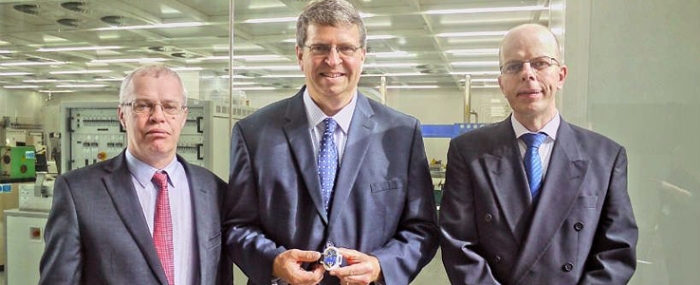
© Sanmina
Electronics Production |
Tyndall and Sanmina partner on wearable health monitoring platform
Tyndall and Sanmina have entered a research collaboration, which will focus on the development of a novel wireless technology for a commercial wrist-worn health-monitoring platform.
The platform will wirelessly monitor heart rate and arterial oxygen saturation (SpO2). Led by the Wireless Sensors Network (WSN) group at Tyndall, the objective of the research partnership is to improve the performance of these wearable platforms by providing more energy efficient wireless communications when compared with existing technology. The project is being funded by Enterprise Ireland through their Innovation Partnership Programme.
At present, Bluetooth wireless technology is in widespread use for short-range wireless sensing applications. It operates in the 2.4 GHz frequency band. However, at these frequencies, the human body has a significant effect on antenna performance, signal reliability and communications range, Sanmina writes in a press release.
As part of this collaboration, Tyndall will develop a sub-GHz wireless solution which is said to have significant benefits for wearable sensing applications compared to existing 2.4 GHz solutions. These benefits include the use of lower power radio technology that leads to increased battery lifetime; the provision of additional communication channels to mitigate current 2.45 GHz saturation in hospital environments; decreased signal loss due to the human body; and increased immunity from radio frequency interference.
“The 915MHz band with integrated antenna is targeting a significant improvement to current Bluetooth protocols which currently operate at 2.4GHz. This band is primarily absorbed by the human body thus depleting battery life because of the human environment. This new RF approach along with some patented technology by Sanmina Corporation may lead to opportunities to integrate the technology into their respective customers’ wearable systems, thus enabling longer battery life for future wearable systems,” said Carlo Webster from Tyndall’s Commercial team.
Dr. John Buckley, Head of the Radio-Frequency Circuits and Systems Team in Tyndall’s WSN Group explains: “The solution that we will develop with Sanmina aims to significantly improve the performance of current wireless sensor technology and enable ultra-low power operation using sub-GHz frequencies. In particular, the goal is to develop a novel sub-GHz antenna design with high immunity to human body effects and combine this with state-of-the-art, low-power radio transceiver technology. This will enable improved reliability of wireless communications and increased battery lifetime that will in turn open up new opportunities in application areas such as personalized medicine and health and wellness applications”.
Robert Newberry, Director of Engineering, at Sanmina Corporation welcomes their partnership with Tyndall said; “Our goal with this innovation partnership is to jointly develop a wearable platform, which can be further extended into both industrial and medical applications in the hope of stream-lining time to market for future wearable solutions. The partnership builds upon the existing collaboration which sees Sanmina combining access to Tyndall’s €200 million of Research and Development (ICT) infrastructure, 500 scientist, engineers and support staff with Sanmina’s global reach and expertise in manufacturing.”



